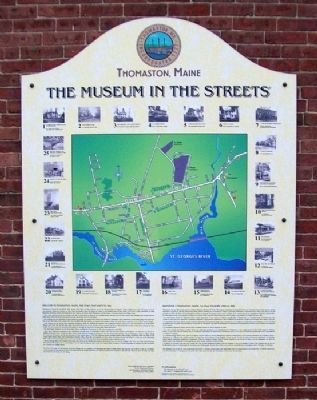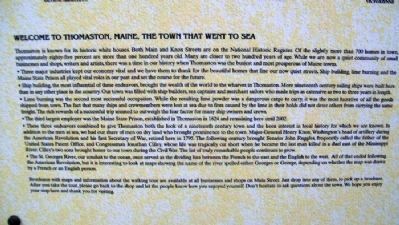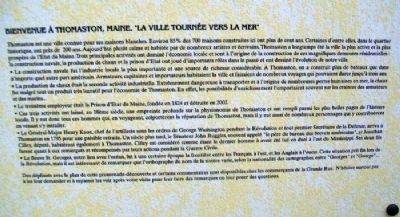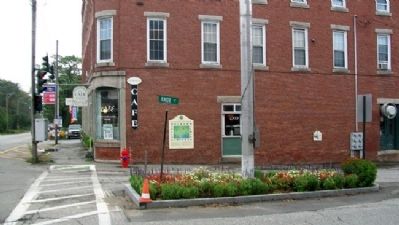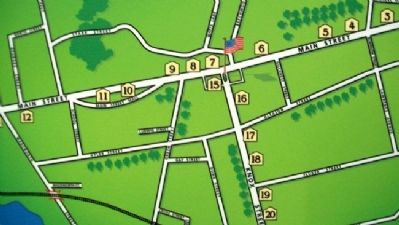Thomaston in Knox County, Maine — The American Northeast (New England)
Thomaston, Maine
The Museum in the Streets
Inscription.
Thomaston is known for its historic white houses. Both Main and Knox Streets are on the National Historic Register. Of the slightly more than 700 homes in town, approximately eighty-five percent are more than one hundred years old. Many are closer to two hundred years of age. While we are now a quiet community of small businesses and shops, writers and artists, there was a time in our history when Thomaston was the busiest and most prosperous of Maine towns.
• Three major industries kept our economy vital and we have them to thank for the beautiful houses that line our now quiet streets. Ship building, lime burning and the Maine State Prison all played vital roles in our past and set the course for the future.
• Ship building, the most influential of these endeavors, brought the wealth of the world to the wharves in Thomaston. More nineteenth century sailing ships were built here than in any other place in the country. Our town was filled with ship builders, sea captains and merchant sailors who made trips as extensive as two to three years in length.
• Lime burning was the second most successful occupation. While the resulting lime powder was a dangerous cargo to carry, it was the most lucrative of all the goods shipped from town. The fact that many ships and crewmembers were lost at sea due to fires caused by the lime in their holds did not deter others from carrying the same freight. The rich rewards of a successful trip seemed to outweigh the fear factor for many ship owners and crews.
• The third largest employer was the Maine State Prison, established in Thomaston in 1824 and remaining here until 2002.
• These three endeavors combined to give Thomaston both the look of a nineteenth century town and the keen interest in local history for which we are known. In addition to the men at sea, we had our share of men on dry land who brought prominence to the town. Major-General Henry Knox, Washington's head of artillery during the American Revolution and his first Secretary of War, retired here in 1795. The following century brought Senator John Ruggles, frequently called the father of the United States Patent Office, and Congressman Jonathan Cilley, whose life was tragically cut short when he became the last man killed in a duel east of the Mississippi River. Cilley's two sons brought honor to our town during the Civil War. The list of truly remarkable people continues to grow.
• The St. Georges River, our conduit to the ocean, once served as the dividing line between the French to the east and the English to the west. All of that ended following the American Revolution, but it is interesting to look at maps showing the name of the river spelled either Georges or George, depending on whether the map was drawn by a French or English person.
Brochures with maps and information about the walking tour are available at all businesses and shops on Main Street. Just drop into any of them to pick up a brochure. After you take the tour, please go back to the shop and let the people know how you enjoyed yourself. Don't hesitate to ask questions about the town. We hope you enjoy your stop here and thank you for visiting.
Thomaston est une ville connue pour ses maisons blanches. Environ 85% des 700 maisons construites ici ont plus de cent ans. Certaines d'entre elles, dans le quartier historique, ont près de 200 ans. Aujourd'hui plutôt calme et habitée par de nombreux artistes et écrivains, Thomaston a longtemps été la ville la plus active et la plus prospère de l'Etat du Maine. Trois principales activités ont dominé l'économie locale et sont à l'origine de la construction de ces magnifiques demeuers résidentielles: la construction navale, la production de chaux
et la prison d'Etat ont joué d'importants rôles dans le passé et ont dessineé l'évolution de notre ville.
• La construction navale fut l'industrie locale la plus importante et une source de richesse considérable. A Thomaston, on a construit plus de bateaux que dans a'importe quel autre port américain. Armateurs, capitaines et importateurs habitaient la ville et faisaient de nombreaux voyages qui pouvaient durer jusqu'à trois ans.
• La production de chaux était la seconde activité industrielle. Extrêmement dangereuse à transporter et à l'origine de nombreuses pertes humaines en mer, la chaux fut malgré tout un produit très lucratif pour l'èconomie de Thomaston. En effet, les possibilités d'enrichissement l'emportaient souvent sur les craintes des armateurs et des marins...
• Le troisième employeur était la Prison d'Etat du Maine, fondée en 1824 et détruite en 2002.
• Ces trois activités ont laissé, au 18ème siècle, une empreinte profonde sur la physionomie de Thomaston et ont rempli parmi les plus belles pages de l'histoire locale. Il y eut donc tous ces hommes qui, en voyageant, colportèrent la réputation de Thomaston, maís il y eut aussi de nombreux personnages qui y contribuèrent en venant s'y installer.
• Le Général-Major Henry Knox, chef de l'artillerie sous les ordres de George Washington pendant la Révolution et tout premier
Secrétaire de la Défense, arriva à Thomaston en 1795 pour une paisible retraite. Un siècle plus tard, le Sénateur John Ruggles, souvent appelé "le père du bureau des brevets américains", et Jonathan Cilley, député, habitèrent également à Thomaston. Cilley est considéré comme étant le dernier homme à avoir été tué en duel à l'est du Mississippi. Ses deux fils furent quant à eux remarqués et récompensés par leurs actions pendant la Guerre Civile.
• Le fleuve St. Georges, notre lien avec l'océan, fut à une certaine époque la frontière entre les Français, à l'est, et les Anglais à l'ouest. Cette situation prit fin lors de la Révolution, mais il est intéressant de remarquer que l'orthographe du nom de la rivière varie, selon la nationalité des cartographes, entre "Georges" et "George"...
Des dépliants avec le plan de cette promenade-découverte et certains commentaires sont disponibles chez les commerçants de la Grande Rue. N'hésitez surtout pas à les leur demander et à repasser les voir après votre visite pour leur faire des remarques ou leur poser des questions.
Erected 2003 by The Museum in the Streets®. (Marker Number Map.)
Topics. This historical marker is listed in these topic lists: Industry & Commerce • Settlements & Settlers • Waterways & Vessels. A significant historical year for this entry is 1824.
Location.
44° 4.73′ N, 69° 10.955′ W. Marker is in Thomaston, Maine, in Knox County. Marker is at the intersection of Main Street (U.S. 1) and Knox Street, on the right when traveling east on Main Street. Touch for map. Marker is at or near this postal address: 154 Main Street, Thomaston ME 04861, United States of America. Touch for directions.
Other nearby markers. At least 8 other markers are within walking distance of this marker. The Builders, the Captains and the Seamen of Thomaston Ships (here, next to this marker); Thomaston Historical Timeline (within shouting distance of this marker); Civil War Soldiers and Sailors Memorial (approx. 0.2 miles away); The Voyage of Captain George Waymouth (approx. 0.2 miles away); War Memorial (approx. ¼ mile away); Near the Old Prison / À Coté de l'Ancienne Prison (approx. 0.4 miles away); Maine State Prison (approx. half a mile away); Former State Prison Site (approx. half a mile away). Touch for a list and map of all markers in Thomaston.
Also see . . . Early History of Thomaston, Maine. (Submitted on May 22, 2012, by William Fischer, Jr. of Scranton, Pennsylvania.)
Credits. This page was last revised on December 3, 2021. It was originally submitted on May 20, 2012, by William Fischer, Jr. of Scranton, Pennsylvania. This page has been viewed 917 times since then and 44 times this year. Photos: 1, 2, 3, 4, 5. submitted on May 22, 2012, by William Fischer, Jr. of Scranton, Pennsylvania.
